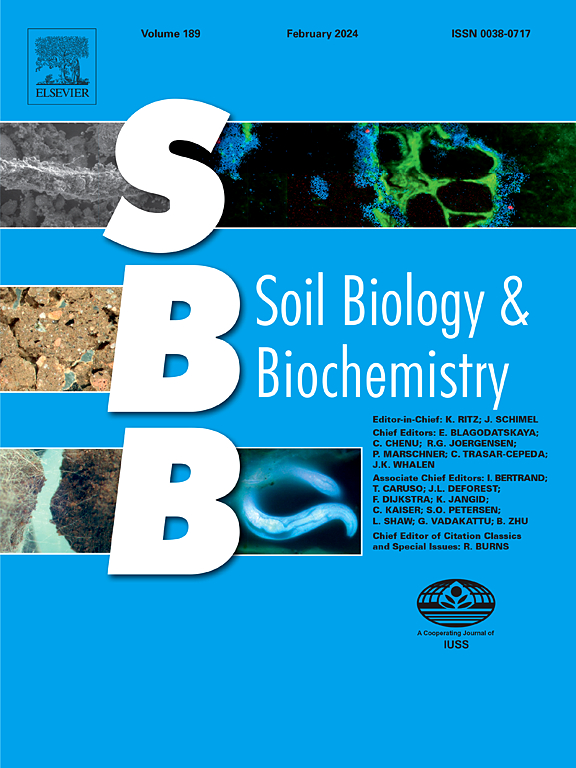Root exudate stoichiometry is a key driver of soil N cycling: implications for forest responses to global change
IF 10.3
1区 农林科学
Q1 SOIL SCIENCE
引用次数: 0
Abstract
Root exudate profile is expected to be altered by global change drivers, with significant implications for plant nutrition. Exposure to elevated atmospheric carbon dioxide (eCO2) increases the quantity and alters the quality of exudates, which likely affects microbial activity and nitrogen (N) cycling. However, it is uncertain whether such changes will result in greater N availability for plants. In this field experiment, we used an automated root exudation system in a forest soil to mimic the increase in exudate C:N ratio observed under eCO2. After six months of continuous application, we measured N transformation rates in O-horizon soils and in root and fungi exclusion soil bags (41 μm and 1 μm mesh sizes) to partition the role of fungi and bacteria. Increasing exudate C:N ratio stimulated gross N mineralization, especially in the rhizosphere, by shifting microbial nutrient acquisition strategy towards a N-mining strategy. High exudate C:N ratio increased nitrification in the absence of roots when both fungi and bacteria were present. These results demonstrate that N transformations are driven more by the C:N stoichiometry than by labile C alone in root exudates, and are largely influenced by the rhizosphere environment. Exudate stoichiometry thus may play a key role in alleviating N limitation under future atmospheric CO2 concentration.


根系分泌物化学计量学是土壤氮循环的关键驱动因素:对森林对全球变化响应的影响
根系分泌物剖面预计会受到全球变化驱动因素的改变,对植物营养具有重要意义。暴露于升高的大气二氧化碳(eCO2)中会增加渗出物的数量并改变其质量,这可能会影响微生物活动和氮(N)循环。然而,尚不确定这些变化是否会导致植物获得更多的氮。在田间试验中,我们在森林土壤中使用自动根系渗出系统来模拟eCO2下渗出物C:N比值的增加。在连续施用6个月后,我们测量了o层土壤和根系和真菌隔离土袋(41 μm和1 μm孔径)的N转化速率,以划分真菌和细菌的作用。渗出液碳氮比的增加通过将微生物养分获取策略转变为氮挖掘策略,刺激了总氮矿化,特别是在根际。当真菌和细菌同时存在时,在没有根的情况下,高渗出物C:N比增加了硝化作用。这些结果表明,根系分泌物中氮的转化更多地受到碳氮化学计量的驱动,而不是单由活性碳驱动,并且在很大程度上受根际环境的影响。因此,在未来大气CO2浓度下,分泌物化学计量学可能在缓解氮限制方面发挥关键作用。
本文章由计算机程序翻译,如有差异,请以英文原文为准。
求助全文
约1分钟内获得全文
求助全文
来源期刊

Soil Biology & Biochemistry
农林科学-土壤科学
CiteScore
16.90
自引率
9.30%
发文量
312
审稿时长
49 days
期刊介绍:
Soil Biology & Biochemistry publishes original research articles of international significance focusing on biological processes in soil and their applications to soil and environmental quality. Major topics include the ecology and biochemical processes of soil organisms, their effects on the environment, and interactions with plants. The journal also welcomes state-of-the-art reviews and discussions on contemporary research in soil biology and biochemistry.
 求助内容:
求助内容: 应助结果提醒方式:
应助结果提醒方式:


